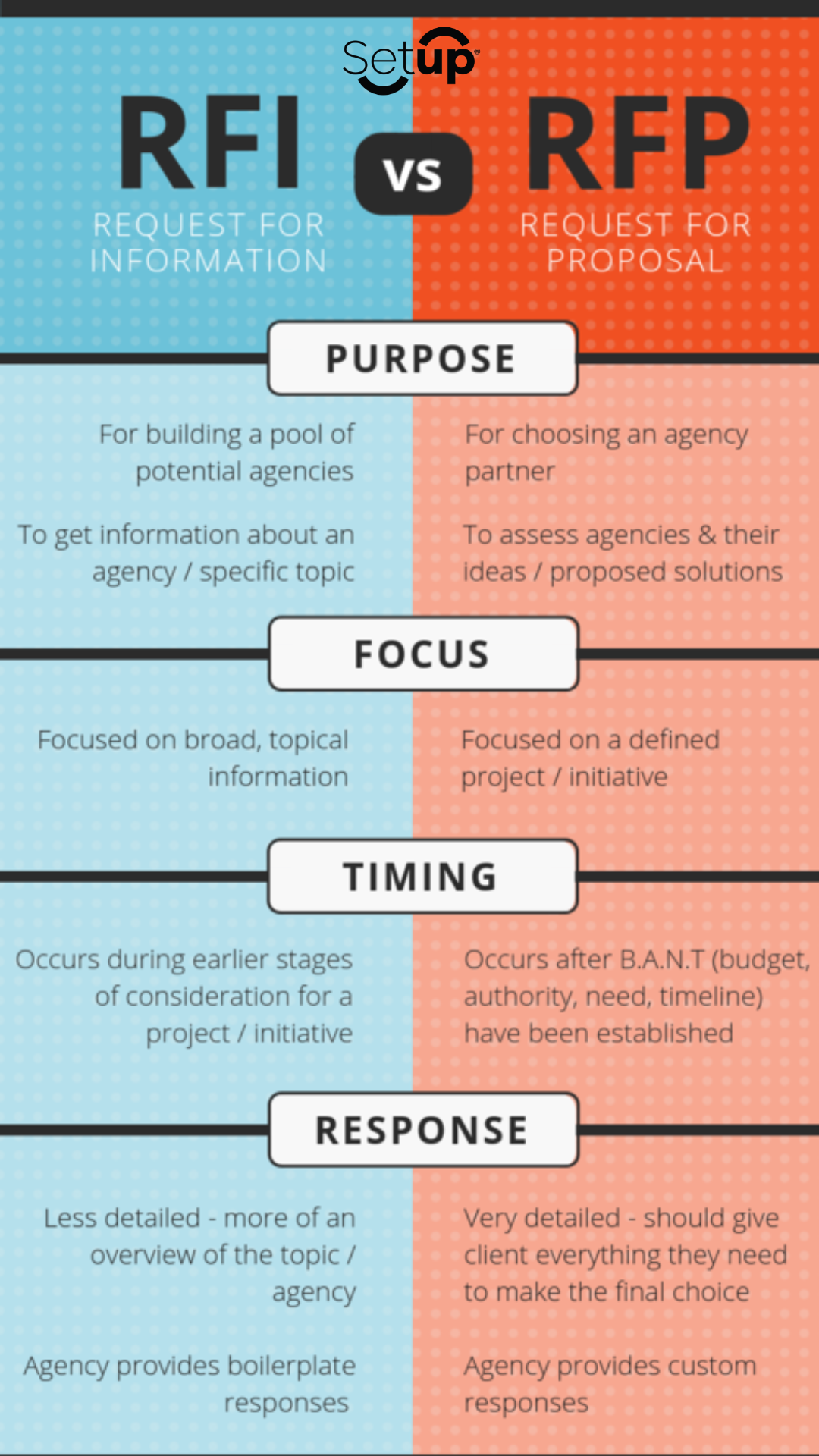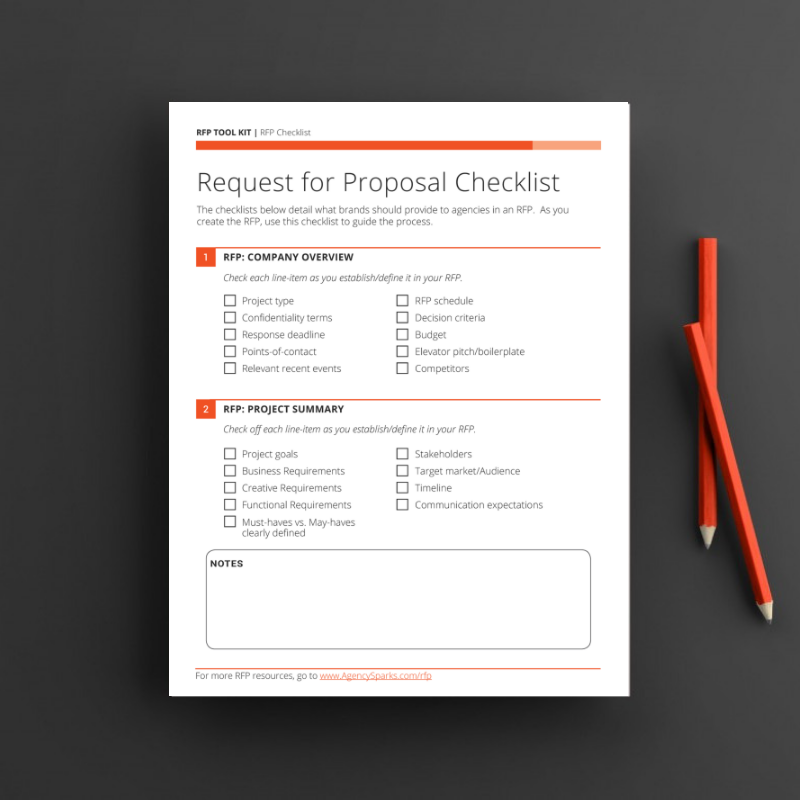For brands creating an RFP, or Request for Proposal, the document provides a structured framework that helps them think through the details of a particular project or marketing initiative. That said, it’s important to get the RFP process right - the first time.
While the RFP process can be long and tedious (often 3-6 months), it can mean the difference between a successful partnership and a complete disaster. For any project that involves a contractual obligation, RFPs offer a thorough and methodical solution to selecting an agency. Not only do RFPs mitigate the risk of entering a disastrous partnership with a vendor, they also help decision makers think through the process and expectations of a given project or initiative.
What is an RFP?
An RFP, or Request for Proposal, is a bid proposal document issued by a client/company to a list of marketing agency partners / vendors. The term RFP refers to both the proposal solicitation process and the RFP document.
This document presents agencies with a list of typical RFP questions about the services, methodology, and costs that will go into fulfilling the company’s needs for this particular project. The process of drawing up an RFP document occurs early in the procurement cycle. The RFP response is drafted by the agency (aka the bidder) and then sent back to the client.
Why use a request for proposal?
RFPs signal that a brand is entering the procurement stage for a particular service - meaning that they’re ready to buy. This encourages competition between agencies submitting proposals.
A well-written RFP gives agencies the necessary context to propose the best solution for the client, while offering a structured framework that helps brands (the issuer of the RFP) think through the details of a project, such as:
project goals,
project budget,
project timeline,
evaluation criteria,
and the procurement process of an agency partner.
RFP Terminology
Master Services Agreement (MSA) An initial contract that spells out the terms between the signing parties at a broad level.
Statement of Work (SOW) A document that defines project-specific activities, deliverables, and timelines for a vendor providing services to the client.
Project Scope The goals, deliverables, features, functions, tasks, deadlines, and costs. Essentially, the boundaries of a project
Related Resource: CTA - SEO - PPC - WTF?? 16 Marketing Agency Acronyms You Need to Know
When should you issue an RFP?
Common circumstances that trigger the RFP process:
Projects that require an outside vendor to work alongside their internal team
When the client’s internal team is missing necessary capabilities (i.e. little/no understanding of an emerging marketing trend or no experience targeting a specific cultural group or industry)
When the client’s internal team does not have the bandwidth to execute on a particular project
Projects that require technical expertise, research and development, or specialized capabilities. It can be email marketing, website development, social media marketing, or the overall digital strategy. The point is not what kind of project it is, rather that there’s a project at all.
Initiatives driven by corporate policy (i.e. the company requires the decision maker to conduct an RFP even though the choice has already been made)
That said, many clients fail to understand the Do’s and Don’ts of the RFP process. Just because a project could go through the RFP process, does not mean that it should.
When companies should issue an RFP
Marketers who default to an RFP for any project/need rather than considering the kind of project requires an RFP will find themselves overwhelmed. There are specific instances where an RFP should be used, like:
A high-stakes situation (like a technical proposal) where the level of investment demands the best possible solution at an ideal price
When the client issuing the RFP knows the end goal of a project but is not aware of what the best possible solution looks like
When clients are unhappy with their current agency partner and regret not being more thorough during the agency vetting process
For expensive projects
For projects that require strict contractual obligations
When companies should not issue an RFP
Though the RFP process requires a lot of work on both sides of the agency-client relationship, every marketing agency wants new business… even if the path to that new business often leads to tedium, frustration, and confusion. Clients should NOT issue requests for proposals when:
Scenario: Client already has project details/specifications of a project laid out and is just looking for a vendor to execute on them for the lowest possible price.
Instead of an RFP: Use an RFQ (request for quotation).
Scenario: Client has no clue what it wants or what the scope of work / project requirements would be.
Instead of an RFP: Write a marketing brief to outline business goals and project scope. Or, explore alternatives to the RFP process.
Scenario: Client does not have the budget to move forward, but wants to start the procurement process anyway.
Instead of an RFP: Start planning your next marketing budget and make room in the budget for this project.
Scenario: Client does not have approval or authority to move forward.
Instead of an RFP: Communicate with company decision makers and do not move forward until B.A.N.T. (budget, authority, need, timeline) is established.
What is the difference between an RFP and an RFI?
Sometimes, client-side marketers use the term “RFP” to apply to something called an RFI, or Request for Information. While RFPs and RFIs are similar in some ways, there are a few key differences.
What is a Request for information (RFI)?
An RFI is a broad, fact-finding document issued by clients at the very beginning of the procurement process. In an RFI, the client asks a fairly standard list of questions that are intended to gain an overview of the vendor and/or an unfamiliar subject area.
When is an rfi used?
Most of the time, RFIs are used to create a pool of potential service providers. In this instance, the RFI will ask questions around the agency’s value proposition, company history, and key capabilities. Sometimes, RFIs are used before an RFP.
How does an RFI differ from an RFP?
RFIs differ from RFPs in that the response to requests for information is more about the vendor/marketing agency than it is about the particular project.
RFIs are more surface-level than RFPs - RFPs are designed to narrow down a list of potential vendors, rather than build a pool of vendors.
RFI example
A brand wants to implement a new email automation software, but the procurement lead in charge of the agency selection process does not have any experience with email automation software - nor the digital infrastructure needed to execute the project. She submits an RFI to a few email marketing agencies to understand what this kind of project will entail and to get to know each of the marketing agencies’ capabilities around email strategy and technology implementation.
*Note: Outside of the marketing industry, the term RFQ, or request for quotation, is also used alongside RFPs. An RFQ is about how much materials will cost.
Back to top
What are the RFP process steps?
Step 1 | Preparation for RFP
Before issuing an RFP, clients should understand what they are looking for on a basic level. In order to do this, they should conduct research online, through internal meetings, and/or meetings with experts/consultants in the field.
Step 2 | Assemble an RFP team
When assembling an RFP team, it’s best to involve both internal and external stakeholders who will be directly impacted by this initiative. This may include customers.
Step 3 | Draft the RFP Document
Be sure to include:
Information about your company
The purpose of the RFP
The nature of the project/initiative
Information about how the RFP process will be managed
Key dates/deadlines that vendors/marketing agencies need to be aware of
The key points of contact within your organization
A request for agency references/case studies
Step 4 | Issue RFP Document to Vendors / RFP Question Period
After a client issues the RFP, there is a period of time where potential agencies can come back with questions about the RFP. After the question period ends, agencies will submit responses to the RFP.
Step 5 | Conduct Agency reviews
After receiving agency responses, the client then reviews each agency’s capabilities, case studies, proposed solutions, as well as call agency references. This is also the stage where clients compare bids.
Step 6 | Select an agency partner
Client determines which agency they would like to partner with.
Step 7 | Onboard Selected agency partner
While not technically part of the RFP process, this occurs immediately following the RFP process.
RFP Template Elements
The following section will give you a general overview of what a request for proposal template should include. For a more in-depth template with an example RFP, download our free RFP template.
Section I | General Information
Client Introduction & Background
Description of organization
Company overview
Industry overview
Project Information
Project goals
Role of the marketing agency partner / Desired agency relationship
Contact Information
Primary liaison’s email & phone number
Email to which questions should be directed to
Location for meetings / presentations
Any other relevant communication guidelines / preferences
Section II | Project Overview / Statement of work
Purpose of the RFP
Project Description
Scope of work / Elements of the proposal
Goals & KPIs
Section for alternative solutions
Budget
Project Timeline / Key Milestones
RFP issue date
RFP question period end date
RFP close date / Agency evaluation period start date
Agency evaluation period end date
Agency selection date
Note: Aim for concrete deadlines for each of these items and be sure to outline any contingencies / obstacles that could impact the timeline.
Proposal Submission Procedure
Minimum submission criteria / Maximum submission criteria
Agency RFP reception statement
Good faith statement
Evaluation criteria
Communications and proposal submission guidelines (include information about when and how the agencies who are chosen to move forward in the process will be notified)
Term of service / Conflicts of interest clause
Section III | Agency Response
Agency Overview
Name, # of Employees, etc.
Products / Services offered
Markets served
Partners
Relevant Experience
Client references
Case studies
Estimated Budget / Resources Required
Fixed & deliverable pricing
Billable hours
Estimated travel expenses
Any other required resources
Resources for RFPs
RFP Tool Kit
RFP Template
Free, editable request for proposal template
RFP CHecklist
Free, interactive PDF
















The RFP process tends to be stale and can neglect the factors that usually make relationships sustainable and mutually beneficial. As advocates of connection and matchmaking, we believe an investment in discovery around the people-element (chemistry, communication, and capabilities) is equally crucial when determining a future agency partner.